|
The LANCIA RALLY 037 have been conceived and built by the FIAT Races Department with an only purpose: to win. At the beginnings of 1980 the FIAT 131 ABARTH gloriously ended its career winning the third World title while, on the scene, new houses prepared themselves to the debut with new rally cars projected with care, searching more and more exasperate performances. In that period the FIA, maximum organization of the driving sports, revisited the technical rules giving possibility to the race cars builder Companies to participate to the competitions homologating only 200 samples in road version. It was born therefore the "GROUP B", maximum races category that granted the possibility to produce few samples to set on the market, but imposed a strict tuning of the competition cars in comparison with the defaults ones. In few words the car that could be admired along the special stages didn't differ, if not in small details, from the one that could be bought in the car shop.
For this reason the LANCIA RALLY 037 in race version is identical to the road version.
From an aesthetical point of view, there are no substantial differences. The car body, magistrally drawn by PININFARINA, differentiates only for the composition and for some small details. The glassfibre, strong material considered too heavy, is replaced by the kevlar, inclusive the doors, in order to make the car lighter. The rear window is made in transparent plexiglass as the side windows endowed with a small slide window for the cockpit ventilation. Also the door mirrors are replaced with two smaller ones, CALIFORNIAN model made by VITALONI and adopted before on the 131 ABARTH and on the LANCIA STRATOS. Finally, on the frontal part, the fog lamps are eliminated, replaced by a four headlamp system mounted on frontal bonnet, and the back rectangular lights replaced by two small indicators of circular form. To note that in the Evolution 2 car the back part of the bumper is missing, on purpose modified to improve the engine cooling in the inferior part. So shaped and relieved of all that "useless" accessories, the LANCIA 037 weights around 960 Kgs. against the 1170 Kgs. of the road sister.
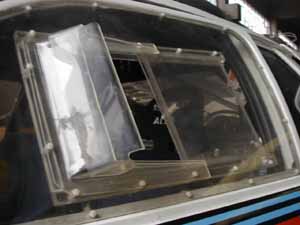 |
PHOTO.1 |
PHOTO.2 |
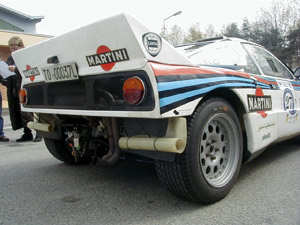 |
Clearly, to have a light car is not enough to be competitive in a rally, but it is necessary to have all that expedients to the set-up, to the engine and to the chassis, on purpose modified for a more exasperated use. The defaults wheel rims are replaced, for instance, with four rims in magnesium of different sketch and measure. The tires - 210/595-15 on the anterior part and 265/40-16 on the rear part - assure therefore a greater grip, considering that the rally roads are often clammy and insidious. Set-up, important thing on the 037, is modified both in the anterior and in the rear part. Anteriorly we find two BILSTEIN not adjustable gas shock absorbers, uniball mounted and endowed with variable flexibility helicoidal springs, while in the rear part an analogous scheme but with two parallel shock absorbers for each wheel with reverse piston rod. A technical solution, revealed then winning in the rallies, it is that to have the possibility of swinging arms diverse linkages. This shrewdness allows many regulations of the wheels geometries allowing to the car a set-up change in short time.
Also the brake circuit is radically modified. The defaults self-ventilated brake disks are replaced with four analogous but detachable ones, with BREMBO pliers with four pumps on the front and two on the rear. Besides the handbrake circuit is twinned and endowed with double separated pump. This to have the possibility to make the car turn in the narrow bends. Finally, to optimize the brake, a particular system of two ways vacuum-servo is used to guarantee a powerful and precise brake, also in precarious adherence situations.
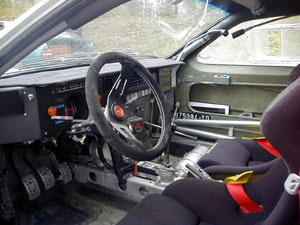 |
PHOTO.3 |
PHOTO.4 |
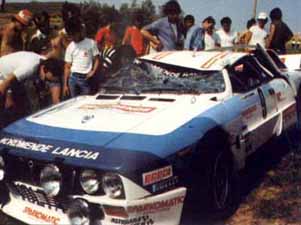 |
In the change of the particulars of the LANCIA 037 - race version - a lot of considerations have been made about safety subject. To make strong and, at the same time, light a rally car has not been an easy job but it is necessary to underline as the ABARTH technicians (apart in the accident of BETTEGA) have succeeded in this difficult operation. During the long career, many drivers have had disastrous accidents (Miky Biasion gone out unhurt from a dreadful somersaults during the 1986 SAFARI RALLY tests, as BETTEGA at the TOUR de CORSE of 1982, although with some fracture) and unfortunately, only a man lost his life on board of this sport car.
The cockpit, driver safety frame, has been deeply studied in each detail. First of all a rugged roll-bar cage with many anchorage points has been installed internally. Then the defaults seats, in comfortable black velvet, have been replaced by two SPARCO contoured seats provided of four linkage point seatbelts. Finally, all the board instruments and the dashboard have been changed with a simpler and lighter preformed model in stailess-steel with matt black coating on the upper part to avoid annoying reflexes on the front window. Inside everything is essential and put in a functional position. The steering wheel, for instance, has a goblet shape (the default one is more flat) and in advanced position in comparison to the driver seat. This shrewdness avoids to the driver stressful work for the shoulders and the bust during the competition where the sudden movements and the fast manoeuvres repeat in rapid succession. Also the stailess-steels pedals have an ergonomic form and are mounted rather close, so to allow to the driver to play with the acelerator, the clutch and the brake pedals. The instrumentation is rough but legible and allows to keep all the mechanical organs under control. We find then the rev counter, the pressure and the engine supercharger manometers, as well as the battery voltage gauge and the fuel level gauge. Many fusibles cut-out and leds, situated in the central part, inform the crew of any failure. On the right side, the co-driver side, we find his working tools: the board computer and the radio-set besides the electonic exchange and the alluminium fire extinguisher to prevent possible fires. The inferior part of the dashboard, finally, is joined with the central tunnel in which there are the gearshift lever and the handbrake lever and the start engine button. To start the engine when it's cold it is necessary to throw a twine positioned in the back part, behind the seats, that directly acts on the injection pump choke.
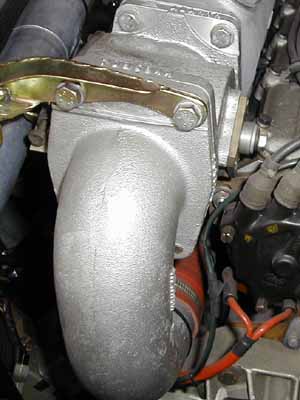 |
PHOTO.5 |
PHOTO.6 |
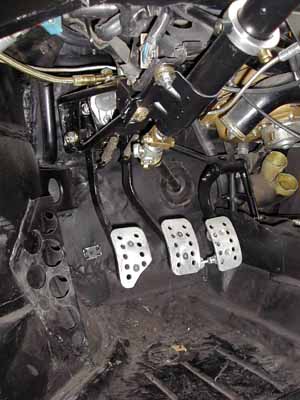 |
The engine, provided with volumex compressor, is the soul and the heart of the LANCIA 037. It is necessary to specify that, during the agonisitics activity, some substantial changes have been made to increase the performances. The EVO I car, at the beginnings of the season 1984, is replaced by the EVO II, lighter, more powerful and more performing car. The first engine elaboration foresaw the use of a KUGELFISCHER mechanical injection system combined to a different VOLUMEX feeder system. The supercharging pressure, now at the maximum rates of torque and power climbs up to 0.9 bar. A new more voluminous air filter replaces the default one, so to allow to the engine to have fresh air coming from an air strangler mounted on the right side of the rear window. Other two lateral air stranglers guarantee besides a suitable ventilation and engine cooling directly carrying the air on the exhaust manifolds and on the volumetric compressor. The throttle control is now performed by a slide valve mounted after the volumex compressor. This principle, already of common use for the race engines, has however a dangerous defect. The elevated temperature reached by the sliding wall valve sometimes stops the slide with consequences that can reveal disastrous. The engine tuning, furthermore, foresaw the adoption of a safety valve on the intake manifold, to prevent an excessive circuit overpressure. This valve, named POP-OFF, is able to let go out the compressed air in excess that could provoke serious damages to the compressor. The flow outcoming from the valve is carried therefore in a metallic box and then sent on a small radiator to cool the gearbox oil. An intelligent solution this one, that allows to take advantage (the oil cooling) using a waste material (air in excess). The exhaust system is not modified, but however adjusted to the performances. It maintains the original scheme: four pipes that become two up to the inside of the exhaust silencer, then to undouble again in two parallel pipes with at the end two swelling end plates with the function of flash suppressor. This particular kind of silencer gives to the car a metallic sound, pleasant to the ear, dull with the engine at the minimum rates but impressive as soon as it increases the rpm. The declared power, with this first tuning level, is of 265 Bhp and, for some model in tarmac order, also of 280 Bhp.
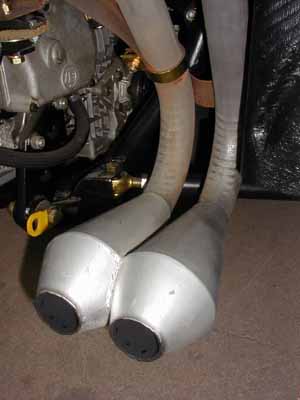 |
PHOTO.7 |
PHOTO.8 |
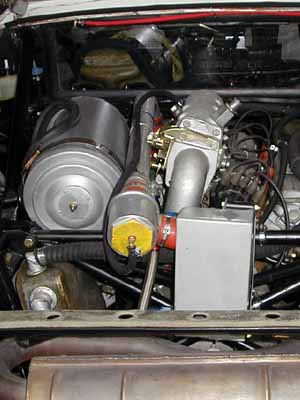 |
At the beginning of the 1983 season, after a run-in year, new substantial changes have been made to the engine system and precisely to the injection and intake schemes. The 1995 cubic capacity remains unchanged but the regulation throttle valve and the intake manifold are reconsidered. Besides, further improvements are made to the fuel injectors position and to the volumex compressor, with increase for this last one of the air delivery and consequent increase of the performances. Now the LANCIA 037 arrives to have 300-310 Bhp at 8000 rpm with a maximum torque of 30.5 Kg/ms at 5000 rpm.
In 1985, last competitive year with the official dress, further technical solutions dictated by the demand to struggle the turbocharged 4 wheel drive engine cars (AUDI Quattro and PEUGEOT 205T16) by now masters of the rally panorama have been made to the engine compressor system. The cubic capacity passes from 1995 to 2111 ccs. with a bore pistons of 85 mms. combined to a stroke of 93 mms and to a compression rate of 9:1. The volumetric compressor is brought to the maximum usable pressure (1 bar) but this fact often caused knock fuel phenomenons inside the fire-boxes because of the high temperature produced under high-stress conditions at low rpm. To avoid this problem, as it was not possible to modify the engine base structure and to add, for space reasons, a cooling circuit, the ABARTH technicians opted for an indeed clever solution: a water injection system controlled by a sensor of air pressure temperature and fed by a small electric pump. This one could be started by the driver if high temperature conditions could expose the engine to risk. The last evolution of the 037 reached very high power levels: some models touched the 350 Bhp with a maximum torque of 33 Kg/ms. The LANCIA 037, so tuned, is able to reach over the 175 Km/h with a burning acceleration that brings it to 100 Km/h in few less than 6 seconds. This also thanks to the five speed gearbox with frontal and close power take-off and with the replaceable final gear to get different maximum speeds according to the kind of race. The more used combination in the competitions of World Championship foresaw a final gear of 5,25 with a series of gears so distributed: first gear 1,875, second gear 1,555, third gear 1,3, fourth gear 1,125 and fifth direct power gear. Finally, the self-locking differential for competitive use was differently set-up in comparison to the default one and brought to an increase of the power threshold percentage of 40-70%. At the end of the 1985 season the 037 officially ends the competitive career and, with it, its development. Other tuners and teams will still make it win up to the end of 1987, to demonstrate that a good rally car stays competitive in the time. The activity of the MARTINI RACING will continue in the World Championship with a new deadly bomb, the LANCIA DELTA S4 that, not by chance, uses the 037 same engine scheme (four cylinders engine with VOLUMEX compressor) with the addition of a turbocharged system. This car for different reasons never had the chance to become World Champion but is considered still today the maximum expression of technology applied to a rally car. The "made in Italy" doesn't have comparison, above all if we consider the great performances of the Italian cars in the world, from the FULVIA HF to the LANCIA STRATOS, from the Fiat 131 ABARTH to the 037, from the S4 to the LANCIA DELTA INTEGRALE, whose seven world titles, six consecutive, belong to the history and will hardly be repeated.
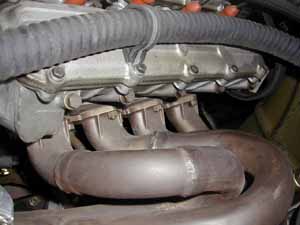 |
PHOTO.9 |
PHOTO.10 |
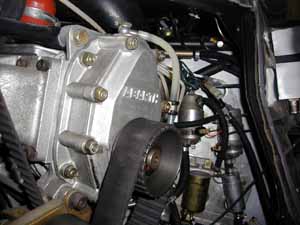 |
| .:: images ::. |
|
PHOTO.1 - Particular of the kevlar door and plexiglass sliding window.
PHOTO.2 - Particular back-side of the car. The bumper absence points out that this is a EVO.2 version.
PHOTO.3 - The cockpit.
PHOTO.4 - The accident of Bacchelli-Spollon during the 1982 Colline of Romagna Rally.
PHOTO.5 - Particular of the rotating valve that replaces the butterflies or sliding valves. At the maximum rates the valve opens completely.
PHOTO.6 - The pedals. Pls note the cut clutch pedal. The car in picture was used by MARKKU ALEN. His drive style evidently required such pedals configuration.
PHOTO.7 - Particular of the exhaust terminal. The two swelling end plates serve as flash suppressor and internally are covered by a riddled pipe.
PHOTO.8 - Particular of the filter-rotating valve-volumex group. Pls note the metallic box on the right. It is used to pick up the overpressure air outcoming from the valve. The air is used for the gearbox oil cooling.
PHOTO.9 - Particular of the exhaust pipes. The four pipes unites in two, then to become one in the silencer and to again undouble up to the flash suppressors.
PHOTO.10 - Particular of the volumetric compressor, water cooled, seen from the cockpit (the panel behind the seats has been removed). Pls note the fuel pumps positioned behind the tank.
|
*** BACK ***
|